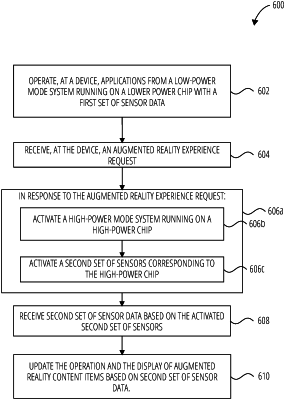| CPC G06T 19/006 (2013.01) [G02B 27/017 (2013.01); G06F 1/325 (2013.01); G06F 3/017 (2013.01); G02B 2027/0138 (2013.01)] | 20 Claims |

|
1. A method comprising:
configuring a low-power mode to run on a low-power processor of an AR device using a first set of sensor data from a first set of sensors of the AR device, and a high-power mode to run on a high-power processor of the AR device using a second set of sensor data from a second set of sensors of the AR device;
operating, using the low-power processor, a low-power application in the low-power mode based on the first set of sensor data, wherein the low-power application is configured to: receive a notification of a new virtual content item based on a geographic location of the AR device, retrieve the new virtual content item, and store the new virtual content item in a memory of the AR device;
detecting a request to operate a high-power application at the AR device;
in response to detecting the request, activating the second set of sensors of the AR device corresponding to the high-power mode;
accessing the second set of sensor data from the second set of sensors with the high-power processor; and
operating, using the high-power processor, a high-power application in the high-power mode based on the second set of sensor data.
|